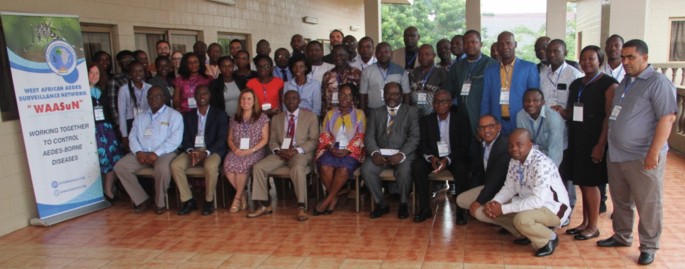
[ad_1]
Aedes-borne arboviral ailments resembling dengue, Zika and chikungunya are being reported with rising frequency throughout Africa, and regardless of being vaccine preventable, yellow fever outbreaks proceed to persist [1,2,3]. In sub-Saharan Africa, the place each the domesticated Aedes aegypti aegypti and the sylvatic Aedes aegypti formosus subspecies originated and coexist [4], the epidemiology of mosquito-transmitted viruses is much less clear as in comparison with the remainder of the world. Within the final 50 years, research on the biology of Ae. aegypti have been primarily carried out on the home kind Ae. aegypti aegypti outdoors the African continent, specializing in its position as a vector and its interactions with people in city and semi-urban environments. Though Africa was the cradle of contemporary Aedes surveillance and management methodologies stemming from the yellow fever analysis actions undertaken within the early twentieth century, present entomological capability is primarily targeted on malaria vectors. This has resulted in an amazing information hole on arbovirus epidemiology in sub-Saharan Africa, whereby most nations lack routine surveillance applications, educated personnel, and management actions which might be targeted on Aedes and the viruses they transmit [5]. As outbreaks of Aedes-borne arboviruses proceed to extend throughout Africa, establishing a powerful public well being entomology infrastructure round Aedes mosquitoes is crucial to each containing and stopping outbreaks.
Given recurrent yellow fever outbreaks and the rising public well being burden resulting from dengue and chikungunya, West Africa is a precedence area for strengthening public well being entomology capacities round Aedes surveillance and management [5]. The thought for the West African Aedes Surveillance Community (WAASuN) arose in 2017 at a gathering held in Freetown, Sierra Leone, comprising African scientists engaged on varied points associated to the biology, management, and surveillance of Aedes mosquitoes. WAASuN goals to strengthen the capability of West African nations to grasp the biology of Aedes mosquitoes and outline their roles as vectors, perform surveillance and management of Aedes arboviral illness vectors, and facilitate collaboration between nations and different companions on varied points of Aedes surveillance and management. WAASuN is now a non-profit group registered in Ghana. The community’s secretariat was formally established on the Noguchi Memorial Medical Institute in Accra, Ghana in July 2019, as a part of the inaugural assembly described on this manuscript. The precise goals of the community embrace (i) strengthening present linkages in Aedes surveillance each inside and between nations, (ii) constructing the capability of member nations in surveillance actions and outbreak preparedness, and (iii) advocating for elevated funding in Aedes surveillance actions in member nations. The community at present has a membership of 60 scientists from West Africa and different associate nations. Herein, we describe the proceedings of the inaugural assembly of WAASuN, held from 8 to 12 July 2019 in Accra, Ghana.
The assembly was opened with welcoming addresses and opening remarks by WAASuN co-chairs Dr. Samuel Dadzie and Dr. Mamadou Coulibaly. Dr. Dadzie introduced the goals of the assembly, which had been to (i) obtain updates from nations on Aedes surveillance actions, (ii) obtain info from different companions on Aedes analysis and surveillance actions and protocols, (iii) share updates on WAASuN actions and the event of the phrases of reference and strategic plan, (iv) take part in a hands-on capability constructing exercise on the laboratory detection of kdr mutations in Ae. aegypti, and (v) community with different attendees (Fig. 1).
The individuals gave shows that summarized the present Aedes surveillance and management actions of their nations. The next nations had been represented: Angola, Benin, Burkina Faso, Cameroon, Cape Verde, Cote d’Ivoire, Democratic Republic of Congo, Gambia, Ghana, Guinea, Guinea-Bissau, Liberia, Mali, Mauritania, Niger, Nigeria, Senegal, Sierra Leone, and Togo.
Shows and updates had been additionally offered from companions, together with the Liverpool College of Tropical Medication and the Partnership for Growing the Affect of Vector Management, which goals to scale back the burden of vector-borne ailments by rising the analysis capability of African and UK scientists and constructing partnerships to develop sustainable vector management options.
The following session reviewed the highlights and takeaways from the previous nation and associate shows. It was agreed that nations have to harness sources and/or work along with profitable applications with sturdy entomology parts resembling nationwide malaria management applications and the US President’s Malaria Initiative to conduct Aedes surveillance. For instance, fairly than discarding the Aedes inadvertently collected throughout routine Anopheles surveillance, a small quantity of funding might enable for the processing of those samples. By additional networking within the area, capability will be enhanced; nations with restricted surveillance capability could possibly be supported by nations with extra superior surveillance actions. Moreover, a One Well being method for arboviral illness outbreaks is vital, as many are zoonotic, and insecticide deployment ought to be knowledgeable by resistance profiles.
It was additionally highlighted that many nations are experiencing comparable challenges. There’s a frequent lack of environment friendly and standardized instruments for Aedes assortment. There may be additionally a scarcity of delicate indices to find out Aedes densities that correlate to illness transmission danger. Insecticide resistance threatens the success of present management methods, and assays utilizing insecticide concentrations meant for detecting resistance in Anopheles will not be acceptable for Aedes. Misdiagnosing arboviral ailments as malaria was additionally a standard problem, as arboviral ailments have comparable signs and manifestations. Moreover, the dearth of funding for Aedes surveillance is a standard problem to initiating, strengthening, and sustaining applications.
Key factors that had been raised in the course of the nation shows had been mentioned. The primary subject was lorry tires, with the consensus {that a} authorized framework to implement laws round tire disposal and storage can be wanted to eradicate them as a key supply of Aedes. As well as, the non-public sector could possibly be engaged to probably recycle tires to be used as chairs, sneakers, or different commodities.
The following level of dialogue centered round appropriate assortment strategies for Aedes. It was decided that the gathering methodology should think about key goals such because the species, mosquito habits, feeding preferences, and so forth., and that one lure sort will not be appropriate for all settings. A number of traps could possibly be examined in several nations and information collected for standardization of strategies. The group usually agreed that ovitraps baited with infusions work finest for egg assortment, BG-Sentinel traps work properly for gathering each indoor and out of doors host-seeking grownup Aedes, gravid traps are most popular for gathering gravid Aedes outside, and US Facilities for Illness Management and Prevention (CDC) mild traps and CDC ultraviolet traps are most popular for sylvatic Aedes species. It was agreed that Prokopack aspirators work properly for indoor resting mosquito collections. Upon gathering Aedes, one other frequent problem is distinguishing between species; though morphological keys exist, they don’t seem to be accessible for all species. Microscopy and molecular assays might help distinguish species, however tools and provides are sometimes missing.
A number of nation shows included information on immature indices, however since these aren’t predictive of illness, some individuals questioned their use. It was mentioned that immature indices are helpful for estimating densities, finding infestations for management efforts, and predicting areas of excessive danger for arboviruses. One key hole recognized is the dearth of formal Aedes surveillance actions in nations.
One other space of dialogue was insecticide resistance testing in Aedes. Diagnostic doses for Aedes haven’t been really useful for a lot of pesticides, so nations usually use the identical doses as for Anopheles. Completely different nations use totally different prone Ae. aegypti strains resembling Bora Bora or New Orleans, however ideally a prone African pressure (such because the one maintained by Benin) ought to be used for reference. Additionally, a big focus has been on phenotypic resistance, however additionally it is vital to doc mechanisms of resistance, and this was recognized as a niche. Problems with heterogeneity of Aedes resistance mechanisms on spatial and temporal scales had been mentioned. For Aedes, it isn’t preferrred to extrapolate outcomes to a wider space when samples from just a few websites are examined.
Capability constructing was one other vital level of dialogue. Some concepts to enhance capability constructing on a regional scale included collaborating with the West African Well being Group, and a number of nations collectively making use of for grants to assist mobilize funding. On this manner, a consortium could possibly be fashioned to embark on tasks by which member nations could possibly be educated.
The assembly additionally contained parts of capability strengthening. Members had been launched to the CDC Epi Information Vector cellular surveillance system, which can be utilized to enter entomological information instantly within the discipline, as an alternative choice to gathering information utilizing paper types. A further part of the assembly was devoted to insecticide resistance, together with an outline of the genetics and dynamics of insecticide resistance in Ae. aegypti. Members additionally participated in a laboratory sensible of real-time polymerase chain response to detect the F1534C, V1016I, and V410L kdr mutations related to insecticide resistance in Ae. aegypti.
The assembly additionally offered a possibility to debate and finalize the phrases of reference and strategic plan for WAASuN. The discussions on the strategic plan had been carried out inside the framework of the goals of the community, which embrace (i) strengthening present linkages in Aedes surveillance each inside and between nations, (ii) bridging the hole between present surveillance techniques within the subregion, (iii) strengthening the capability of member nations in surveillance actions and outbreak preparedness, and (iv) advocating for funding of Aedes surveillance actions in member nations. On the finish of the discussions, members agreed on a 5-year key exercise plan for the community, together with (i) planning and internet hosting of the following assembly in Côte d’Ivoire, (ii) useful resource mobilization by fee of dues and proposal writing, (iii) neighborhood training actions, and (iv) capability constructing in varied points of Aedes surveillance and management inside member nations.
The assembly closed with a dialogue of the goals to perform earlier than the following WAASuN assembly, which had been deliberate for Côte d’Ivoire in July 2020 however was postponed till 2022 resulting from COVID-19. These goals included registering WAASuN as a non-governmental group in Ghana, finalizing the phrases of reference and strategic plan and circulating them amongst members, updating membership phrases and dues, and getting ready the proceedings of this assembly for publication. For the reason that assembly, WAASuN members have continued to supply management on Aedes surveillance in West Africa and have utilized for funding alternatives. Key members of the community have been instrumental in supporting the World Well being Group’s Particular Programme for Analysis and Coaching in Tropical Illnesses within the drafting of the Aedes surveillance entomological protocol, which is at present being piloted in some West African nations. Members of the community have additionally been offering help to the West African Well being Group and the World Well being Group’s Particular Programme for Analysis and Coaching in Tropical Illnesses by constructing the entomological capability of seven West African nations, Niger, Nigeria, Cape Verde, Mauritania, Burkina Faso, Senegal and Côte d’Ivoire, in Aedes vector surveillance. In conclusion, the inaugural assembly of WAASuN solidified a construction and mechanism for West African nations to extend concentrate on Aedes surveillance actions in preparedness for future outbreaks of arboviral ailments.
[ad_2]
Supply hyperlink
